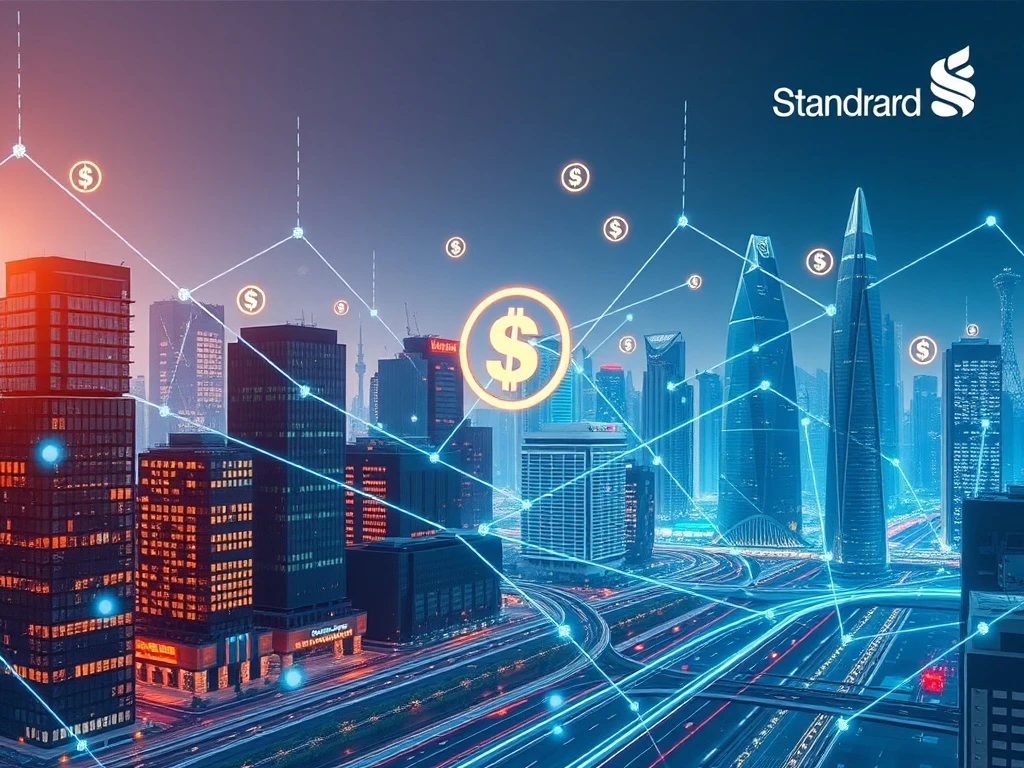Tokenized RWAs Poised for Explosive $2 Trillion Growth by 2028: Standard Chartered’s Bold Prediction

The financial world is undergoing a seismic shift, and at its core lies the burgeoning field of tokenized RWAs. For investors and enthusiasts deeply engaged in cryptocurrencies, understanding the potential of real-world assets migrating onto blockchain rails is crucial. A recent report from investment banking giant Standard Chartered has sent ripples across the industry, projecting an astonishing $2 trillion valuation for tokenized real-world assets by 2028. This figure would match the current market capitalization of stablecoins, signaling a profound transformation in how we perceive and interact with traditional investments.
Standard Chartered’s Bold Vision for Tokenized RWAs
Investment bank Standard Chartered recently shared a groundbreaking prediction. Its analysts foresee tokenized real-world assets reaching a cumulative value of $2 trillion within the next five years. This significant projection underscores a growing confidence in blockchain technology’s ability to revolutionize traditional finance. The bank’s report, shared with Crypto News Insights, highlights how global capital and payments are migrating to more efficient blockchain rails. Consequently, the “trustless” structure of decentralized finance (DeFi) is ready to challenge the long-standing dominance of traditional financial (TradFi) systems. These systems have historically relied on centralized entities.
The anticipated $2 trillion market capitalization by 2028 represents a massive influx of capital. Standard Chartered meticulously breaks down this projection into key segments:
- $750 billion: Expected to flow into tokenized money-market funds.
- $750 billion: Projected for tokenized US stocks.
- $250 billion: Allocated to tokenized US funds.
- $250 billion: Directed towards “less liquid” private equity segments. This includes commodities, corporate debt, and tokenized real estate.
This detailed allocation shows the diverse range of assets poised for tokenization. It also illustrates the widespread impact across various financial sectors.
Understanding the Rise of Tokenized Real-World Assets
Tokenized RWAs represent a pivotal innovation in the digital asset space. Real-world assets (RWAs) are tangible or intangible assets that exist in the physical world. Examples include real estate, commodities, art, and even intellectual property. Tokenization converts these assets into digital tokens on a blockchain. This process brings several advantages, including increased liquidity, fractional ownership, transparency, and reduced transaction costs. Currently, the cumulative value of tokenized RWAs stands at approximately $35 billion, according to data from RWA.xyz. Standard Chartered’s prediction of $2 trillion by 2028 implies an over 57-fold growth from this present value. This exponential expansion highlights the immense potential seen in this emerging sector. The shift is not merely about digital representation; it is about fundamentally improving how assets are owned, traded, and managed.
Stablecoin Market Fuels DeFi Growth Cycle
A critical prerequisite for the rapid expansion of tokenized RWAs is robust stablecoin liquidity and a thriving DeFi banking ecosystem. Standard Chartered’s global head of digital assets research, Geoff Kendrick, emphasizes this connection. “Stablecoin liquidity and DeFi banking are important pre-requisites for a rapid expansion of tokenised RWAs,” Kendrick states. He adds, “We expect exponential growth in RWAs in the coming years.” The total stablecoin supply recently reached a new record, exceeding $300 billion. This occurred on October 3, marking a remarkable 46.8% year-to-date growth rate. This expansion of the stablecoin market directly reinforces the broader DeFi growth ecosystem. Kendrick explains, “In DeFi, liquidity begets new products, and new products beget new liquidity.” He concludes, “We believe a self-sustaining cycle of DeFi growth has started.” This cycle creates a fertile ground for the adoption and success of tokenized RWAs.
The Transformative Impact of Blockchain Technology
The migration of traditional assets onto blockchain rails represents a fundamental shift. This transformation is driven by the inherent efficiencies and security offered by blockchain technology. Unlike traditional financial systems, blockchain offers transparency, immutability, and programmability. These features allow for the creation of “trustless” financial instruments. Consequently, intermediaries and their associated costs diminish. This makes financial processes faster and more accessible. Blockchain’s distributed ledger technology ensures that every transaction is recorded and verifiable. This dramatically reduces fraud and increases confidence. For instance, tokenized US stocks or real estate can be traded 24/7, with settlement occurring almost instantly. This contrasts sharply with the slow, often opaque processes of conventional markets. Furthermore, smart contracts automate various aspects of asset management. They ensure compliance and execution without human intervention. This efficiency is a powerful draw for global capital seeking better returns and lower operational overheads.
Navigating Regulatory Challenges for Future Growth
Despite the immense optimism surrounding tokenized RWAs and DeFi, significant hurdles remain. Standard Chartered’s report identifies regulatory uncertainty as the single biggest threat to the sector’s progress. The lack of clear, comprehensive legislation could impede the rapid expansion predicted. This uncertainty deters institutional investors and large corporations from fully committing to the space. The report specifically warns that progress could stall if the Trump administration, or any subsequent administration, fails to deliver comprehensive crypto legislation. This legislative void, especially before the 2026 midterm elections, creates an environment of hesitation. For the tokenized RWA market to truly flourish and reach its $2 trillion potential, clear regulatory frameworks are essential. These frameworks must protect investors while fostering innovation. Policy clarity will provide the necessary foundation for mainstream adoption and sustained growth.
In conclusion, Standard Chartered’s forecast for tokenized RWAs by 2028 is a powerful indicator of the financial landscape’s future direction. The synergy between a booming stablecoin market, accelerating DeFi growth, and the inherent advantages of blockchain technology creates an irresistible force. While regulatory clarity remains a critical challenge, the fundamental shift towards more efficient, transparent, and accessible financial systems appears inevitable. Investors should closely watch this space as real-world assets increasingly find their digital home on the blockchain.









